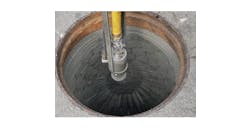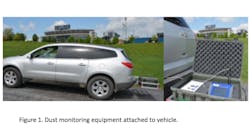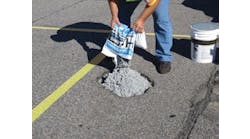The Pope County Highway Department in Minnesota has seen great success incorporating an inexpensive base stabilization product in reconstruction projects using reclaimed and salvaged material, and planned to add it to a full-depth reclamation project.
Brian Noetzelman, Pope County Engineer, said, “We reconstruct a road and then pave it the following year. We get a much better finished product by allowing the roadway to go through a freeze-thaw cycle. The downside to leaving the roadway gravel for that time is the constant maintenance. We are typically blading the roadway at least two times per week during that period.”
Pope County recently reconstructed County State Highway No. 3 with an average daily traffic (ADT) of 400 north of Cyrus, Minn., and incorporated Base One Aggregate Base Stabilizer into the gravel base with hopes of eliminating some of the maintenance on the roadway. Pope County reclaimed and salvaged the existing base and bituminous, and this material became the bottom 4-in. layer of its gravel base section after reconstruction. Pope County added another 4 in. of Minnesota Department of Transportation Class 5 modified aggregate base to complete the grading section.
“We modified the No. 200 sieve to 6% to10% passing,” said Noetzelman. The aggregate base stabilizer was added to the water utilized during the mixing and compacting operation of the gravel base. Not only did it reduce the maintenance on this roadway, it practically eliminated it. “We bladed the roadway once about a month after construction, once before freeze up and then once after the spring thaw,” he continued. “All total we bladed it three times over a span of about a year.”
The stabilized base helped with the paving the following year. “I felt it provided the strength necessary to support hauling the additional gravel base and bituminous without having one blowout. Even the contactor commented on how nice it was to work on a good hard road,” Noetzelman said.
Because of past success, Pope County planned on incorporating an aggregate base stabilizer in a full-depth reclamation project in 2007. The following are details and results of the job.
Farming it out
County Road No. 28 in Pope County, Minn., is a 4.2-mile section of rural roadway that was built in 1969, when the roadway received its first bituminous surface. This section of roadway is populated with farms and is used primarily as a farm-to-market route. In the earlier years, farm equipment was smaller and lighter than it is today. The current roadway was last resurfaced in 1986. Pope County Road No. 28 has a 22-ft-wide bituminous surface and 3-ft gravel shoulders. The 2007 average daily traffic (ADT) was 130 vehicles per day.
The county had received complaints from the public on its poor condition and rough ride. The roadway was showing signs of deterioration due to age, larger farm equipment and poor base. The county was faced with a roadway that was in need of rehabilitation.
The county entertained four possible solutions. The first option would be to do nothing at all and live with the complaints and safety issues. The second option would be to do a 3-in. overlay over the existing bituminous surface at an estimated cost of $500,000 for the 4.2 miles. The third option considered was to do a full-depth reclamation project with a bituminous surface on the 4.2 miles with an estimated cost of $750,000. The fourth option was to do a complete reconstruction of the 4.2-mile section, which was estimated to cost the county $1.7 million.
The county selected the third option—full-depth reclamation with a bituminous surface and the addition of an aggregate base stabilizer to stabilize the reclaimed material prior to paving.
“We chose the full-depth reclamation option for a few reasons,” said Noetzelman. “It was less expensive than doing a complete reconstruction project. We also felt the full-depth reclamation would perform better than an overlay and reduce the chance of reflective cracking in the new bituminous surface.
“By choosing to reclaim the roadway, it allowed us to be green and use the existing material for the base. It also allowed us to keep the roadway open for local traffic. If we would have elected to do a complete reconstruction, it would have increased the cost and timeline by hauling out the old material and hauling in new. We also would have had to close the roadway for approximately 60 days.”
Riley Brothers Construction Inc. of Morris, Minn., was the main contractor on the project, with assistance from Road Reclaimers Inc. of Belgrade, Minn. The contractors used a Terex RS 800 reclaimer to grind up and mix the 4 in. of bituminous and 4 in. of Mn/DOT Class 5 gravel base to a minimum depth of 8 in. The sub-base material was Mn/DOT Class 3. The reclaimed material was windrowed and the bottom 4 in. was shaped with a Caterpillar 14G motor grader and compacted with a John Deere tractor and a pneumatic roller in two 2-in. layers. The upper 4 in. of reclaimed material was treated with the aggregate base stabilizer at a cost of less than $5,000 per mile. It was mixed with water in a Mack 3,000-gal water truck and distributed on the roadway in between each lift. The stabilized reclaimed material was shaped with the motor grader and compacted with a pneumatic roller. This existing roadway was reclaimed and the centerline culverts were replaced in a week.
Normally, the project would be suspended for 20 working days to let the aggregate base stabilizer cure with the reclaimed material. Due to scheduling conflicts and weather, work was suspended for approximately 60 days. The stabilized base provided additional strength for the reclaimed material, which provided a good driving surface for public traffic and construction equipment. No maintenance was needed until the final shaping was done prior to the addition of the bituminous surface. A 2-in. bituminous base course and 1-½ in. bituminous wear course was added after the working days resumed. The roadway was then shouldered and the striping was completed.
The paving process of County Road No. 28 went very well. The full-depth reclamation project was $950,000 less than doing a complete reconstruction project. The solid road base allowed the contactor to earn incentives for ride and density during the paving operations of the project.


